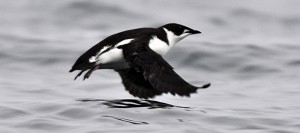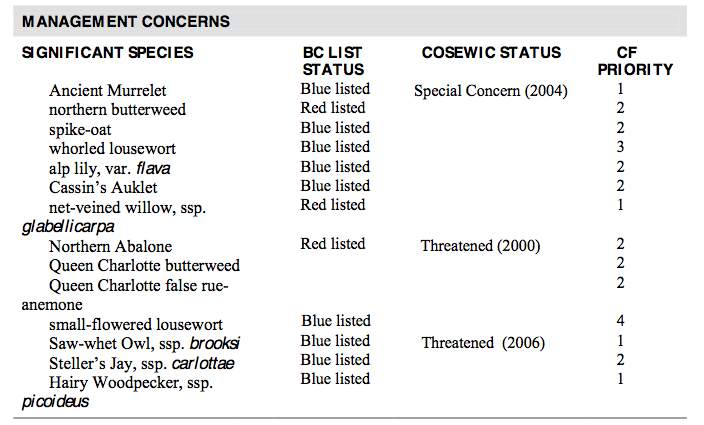
News/Reports
Overview Vladimir J. Krajina (Port Chanal) ER #45
ORIGINAL PURPOSE
To protect representative ecosystems, rare genetic resources, endemic
wildlife, plants and plant communities and outstanding biological
phenomena in a remote coastal setting
Physical:
Located on the west slope of the Queen Charlotte Ranges, the reserve includes mountainous terrain to 825 m in elevation, 60 km of marine shoreline, two large islands, and a fjord (Port Chanal). Slopes facing the inlet are steep, while moderate to flat terrain occurs on the outer two-thirds of the peninsula between Port Chanal and Nesto Inlet and along Mace Creek. Shorelines are mostly steep and rocky with exposed headlands and frequent cliffs. Beaches of shingle and mud occur at the head of Port Chanal at the mouth of Mercer Creek. Surficial materials include extensive colluvium on steep slopes, lesser areas of till on gentle slopes and alluvium in valley bottoms, plus organic materials and marine deposits. Soils of the forested slopes are mainly Podzols of moderate depth and medium to coarse texture. Regosols and Gleysols occur on floodplains and organic soils in the boggy areas.
One relatively large lake (Mercer Lake), several small lakes (one on Hippa Island), the entire watershed of Mace Creek, and several minor creeks are also within the reserve.
See the complete PDF : VJ Krajina ER 45
Biological:Plant communities in the reserve reflect its diverse topography, substrates, and climate. Old-growth coniferous forest with mossy understory predominates, but barren headlands, estuarine meadows, bogs, and alpine habitats are present. The coniferous forest shows remarkable variation in composition and form over short distances, from luxuriant almost pure stands of huge Sitka spruce in sheltered valleys, to more typical western hemlock dominated lower slopes, mountain hemlock-yellow cedar-shore pine forest in the subalpine zone (this often being of krummholz form at its upper margin), and finally barren alpine lands which extend to unusually low elevations.
Spruce-dominated forest is largely in Mace Creek valley, the next valley to the south, and at the head of Mercer Lake. On alluvial sites these magnificent trees, up to three meters in diameter, have a very open, grassy, understory containing Pacific reedgrass, Alaska oniongrass, nodding trisetum, and false lily-of-the-valley. The more widespread western hemlock-western redcedar forest contains scattered Alaskan blueberry and red huckleberry shrubs, occasional deer fern, and a nearly continuous ground cover of mosses. Higher elevations and boggy sites support less vigorous mixtures of yellow cedar, mountain hemlock, and shore pine, with ground cover of sphagnum moss, sedges, and other wetland plants. Interesting blanket bogs, typically on sloping ground and interrupted by rock outcrops, are common on the western peninsula.
Plant communities of the Mace Creek estuary demonstrate typical zonation related to salt tolerance and degree of tidal inundation: a small area of Pacific reedgrass occurs in the fresh water-dominated upper marsh, a more extensive meadow barley-␣ sedge stands in the mid-intertidal area, and dwarf alkali grass in the lower zone.
To date over 130 species of higher plants have been identified here, including several forms that are endemic to the Queen Charlottes or are rare in B.C. The area is particularly rich in liverworts and mosses, 180 species having been recorded, of which no less than 40 are presently considered by experts to be rare. The reserve is the type location for two species of sphagnum moss, Sphagnum schofieldii and S. wilfii.
Hippa Island supports large nesting colonies of Ancient Murrelets, Cassin’s Auklets Fork-tailed Storm Petrels. The murrelets (40, 000 pairs) nest in greatest densities along the northeast coast, up to 500 m inland in mossy old-growth spruce forests. The auklets (12, 500 pairs) prefer grassy, semi-open spruce stands within 60 m of the shoreline, along the northwest coast. A few Pigeon Guillemots and Black Oystercatchers nest around the shoreline, and several breeding pairs of Bald Eagles and Peregrine Falcons are present. Elsewhere in the reserve, Canada Geese and Green- winged Teal frequent Empire Anchorage and Mace Creek estuary, while the forests are home to three endemic birds, the Queen Charlotte Island sub- species of Northern Saw-whet Owl,Steller’s Jay, and Hairy Woodpecker.
All land mammals native to the Queen Charlottes are expected to occur in the reserve. About 300 Steller Sea Lions use Hippa Island as a winter haul-out; harbour seals are common year round.
Four species of Pacific salmon spawn here. The Mercer Lake system is
important for up to 8000 Sockeye Salmon whose young spend a year in the lake as smolts. Pink Salmon also spawn in Mercer Creek, and Coho and Chum salmon in both Mercer and Mace Creeks.
THREATS:
Climate Change: Being a reserve that represents such a high degree of biodiversity and variability, its value will only increase as we
observe the effects of climate change on natural ecosystems. Many possible effects may include intertidal, subtidal and terrestrial habitat loss and/or degradation due to raised sea levels and increased storm activity along the coastlines. Disturbance within the fjord will pose a particular threat to the shorebirds that use the areas for nesting.
The warming of the sea surface temperature combined with altered patterns and quantities of runoff from the island may also change the composition of the marine community, thus altering the associated terrestrial communities. A similar shift in predator/prey relations may result from possible drought conditions, lower water levels in wetland areas and lakes and subsequent changes in water quality.
At high risk in this reserve are the endemic species, such as the Saw-whet Owl, Stelle␣␣␣␣Jay, Hairy Woodpecker, and several plant species. Due to dispersal constraints such as habitat fragmentation or extreme specialization, such unique species may be unable to migrate or adapt to the changing environment.
Access: Boaters accessing the foreshore of the reserve disrupt seabird populations as well as sea lion haul-out areas. Fishing may also occur.
Forestry: Encroaching logging activity is endangering the Sockeye Salmon population and impacting the watershed.
Harvest: Commercial/guided fishing has depleted the waters of salmon, subsequently depleting the ecosystem of vital marine nutrients. Coastal bears are particularly affected as salmon are estimated to comprise 80% of their diet.
Likely poaching of endangered Northern Abalone puts population at risk of extirpation
Forestry: Encroaching logging activity is endangering the Sockeye Salmon population and impacting the watershed.
Harvest Commercial/guided fishing has depleted the waters of salmon, subsequently depleting the ecosystem of vital marine nutrients. Coastal bears are particularly affected as salmon are estimated to comprise 80% of their diet.
Likely poaching of endangered Northern Abalone puts population at risk of extirpation
Non-native species :Raccoons are preying on the seabird population.
Transportation: Flight traffic disrupts the nesting seabird colonies.
RESEARCH OPPORTUNITIES: Baseline reports and lists are available on marine flora and fauna; forest, bog and estuary vegetation; and seabird surveys. Monitoring the effects of climate change on both the marine and terrestrial environments could help our understanding of the importance of heterogeneous landscapes to organisms surviving climate change.
Flora
alkaligrass, dwarf (Puccinellia pumila)
barley, meadow (Hordeum brachyantherum ssp. brachyantherum)
blueberry, Alaskan (Vaccinium alaskaense)
butterweed, northern (Packera cymbalaria)
butterweed, Queen Charlotte (Packera subnuda ssp. moresbiensis)
fern, deer (Blechnum spicant)
fescue, red (Festuca rubra ssp. rubra) hemlock, mountain(Tsuga mertensiana)
hemlock, western (Tsuga heterophylla)
huckleberry, red (Vaccinium parvifolium)
lily, alp (Lloydia serotina var. flava)
lily-of-the-valley, false (Maianthemum dilatatum)
lousewort, small-flowered (Pedicularis parviflora ssp. parviflora)
lousewort, whorled (Pedicularis verticillata)
moss, peat (S. wilfii) moss, peat (Sphagnumschofieldii)
oniongrass, Alaska (Melica subulata)
pine, shore (Pinus contorta var. contorta)
redcedar, western (Thuja plicata) reedgrass, Pacific (Calamagrostis nutkaensis)
rue-anemone, Queen Charlotte false (Enemion savilei)sedge, Lyngbye’s (Carex lyngbyei ssp. cryptocarpa)
spike-oat (Helictotrichon hookeri)
spruce, Sitka (Picea sitchensis)
tristeum, nodding (Trisetum cernuum)
willow, net-veined (Salix reticulata ssp. glabellicarpa)
yellow-cedar (Chamaecyparis nootkatensis)Fauna
Fauna
Abalone, Northern (Haliotis kamtschatkana)
Auklet, Cassin’s auklett (Ptychoramphus aleuticus)
Eagle, Bald (Haliaeetus leucocephalus)
Falcon, Peregrine (Falco peregrinus)
Goose, Canada (Branta Canadensis)
Guillemot, Pigeon (Cepphus columba)
Jay, Steller’s (Cyanocitta stelleri ssp. carlottae)
Murrelet, Ancient (Synthliboramphus antiquus)
Owl, Northern Saw-whet brooksi subspecies (Aegolius acadicus ssp. brooksi)
Oystercatcher, Black (Haematopus bachmani)
Salmon, Chum (Oncorhynchus keta)
Salmon, Coho (Oncorhynchus kisutch)
Salmon, Pink (Oncorhynchus gorbuscha)
Salmon, Sockeye (Oncorhynchus nerka)
Sea Lion, Stellar (Eumetopias jubatus)
Seal, Harbour (Phoca vitulina)
Storm-petrel, Fork-tailed (Oceanodroma furcata)
Storm-petrel.Fork-tailedOceanodroma leucorhoa)
Teal, Green-winged (Anas crecca)
Woodpecker, Hairy picoides subspecies (Picoides villosus ssp. picoideus)


